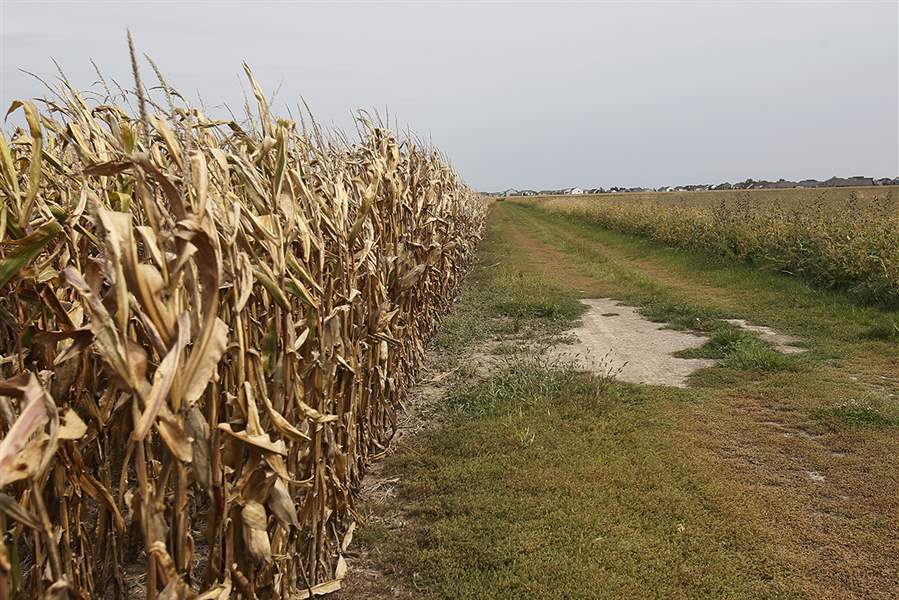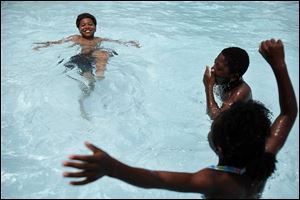
Summer dawns for region with variety of forecasts
National Weather Service predicts moderate weather for season
6/21/2014
Some forecasters are calling for hotter than normal and somewhat drier conditions this summer, which would be a repeat of some dry spells the Toledo area experienced last year. Summer arrived at 6:51 a.m. today.
THE BLADE
Buy This Image

Some forecasters are calling for hotter than normal and somewhat drier conditions this summer, which would be a repeat of some dry spells the Toledo area experienced last year. Summer arrived at 6:51 a.m. today.
Summer officially arrives just after sunrise in Toledo today, and if you’re looking for an excuse to buy a new air-conditioning system or book a two-week stay at a remote cabin near a lake, then heed what the Old Farmer’s Almanac predicts it will be like.
That would be “hotter than normal,” and somewhat drier although with a spate of stormy weather in July.
Of course, then you’re trusting a source that also might have had you selling your snowblower back in November, based on its Toledo winter forecast for milder-than-normal temperatures and below-average snowfall.
The National Weather Service outlook for the summer of 2014 in the Great Lakes region, by contrast, is much less exciting.
According to a three-month trend issued Thursday by the Climate Prediction Center in College Park, Md., the region has an “equal chance” for above-average, normal, or below-average temperatures and precipitation between now and mid-September.
If you head south, the chances of warmer-than-normal weather increase, according to that forecast. Weather trends favor a warm summer in southern Ohio and a hot one in a broad area of the south stretching from Texas to Georgia and as far north as West Virginia, the West service said.

Most city of Toledo pools will open today, the longest day of the year. The National Weather Service expects summer in the city to begin sunny and mild.
The government’s forecasters also expect drier than normal weather along the Gulf Coast from the western Florida Panhandle to the Mexican border, cooler than normal in the Upper Midwest, hotter than normal in the Pacific Coast states and especially Alaska, and wetter than normal in the Northern Plains and central Rocky Mountains.
Summer officially arrived today at 6:51 a.m. Toledo time, the time this year at which the Earth’s tilt on its polar axis leans the Northern Hemisphere farthest toward the sun.
That lean makes the days longer this time of year, and today is the longest day of the year, with about 15 hours, 12 minutes, and 12 seconds between sunrise and sunset in Toledo. Sunday will be about three seconds shorter, while Friday was less than one second shorter.
The National Weather Service expects summer in Toledo to start out sunny and mild, with high temperatures today in the upper 70s, Sunday around 80, and Monday in the mid-80s, with a chance of thunderstorms returning Sunday night and Monday after two dry days.
The Farmer’s Almanac, not to be confused with the Old Farmer’s Almanac, expects the rest of June to be warmer than normal and stormy, with dry weather to follow in early July, showery conditions mid-month, and heat waves in late July and mid-August.
Jay Berschback, chief meteorologist at WTVG-TV Channel 13 in Toledo, said he chooses not to make seasonal predictions.
“I don’t believe in long-term forecasts. There are too many variables, and too much time,” he said.
But better computers are gradually making such forecasting a little better, Mr. Berschback said.
“The faster our computers get, the faster we’re latching onto patterns, trends, oscillations” and other natural phenomena that help signal what the weather will do, he said. “In the future, I expect there to be some more useful long-term forecasts.”
Contact David Patch at: dpatch@theblade.com or 419-724-6094.